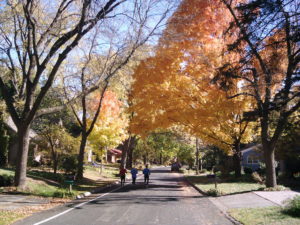 Not every city in Wisconsin has a municipal code or ordinance that includes trees, and even then, those that do have codes may not have forest-friendly ones. A new resource has been created and has taken care of the hard work of determining if your city’s codes are forest-friendly; and if they are not, the resource provides advice on how trees can be more welcome in your neighborhoods. Continue reading “Does your community have forest-friendly development practices?”
Not every city in Wisconsin has a municipal code or ordinance that includes trees, and even then, those that do have codes may not have forest-friendly ones. A new resource has been created and has taken care of the hard work of determining if your city’s codes are forest-friendly; and if they are not, the resource provides advice on how trees can be more welcome in your neighborhoods. Continue reading “Does your community have forest-friendly development practices?”
Care for your woods
Phillips High continues evaluating community trees
Phillips High School students are showing the value of trees in their community. For the past three years the students have been inventorying the trees in the community. Over those years the project has continued to grow each year, from collecting data on trees to identifying planting sites, and now building community awareness by putting price tags on trees. Continue reading “Phillips High continues evaluating community trees”
Public comment period for HRD treatment guidelines revision closes October 16
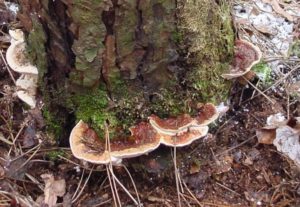
A fruiting body of Heterobasidion irregulare at the base of a pine tree.
By Kyoko Scanlon, forest pathologist, Fitchburg. Kyoko.Scanlon@wisconsin.gov; 608-235-7532
Wisconsin DNR is seeking public comments on a proposed revision to preventative treatment guidelines for Heterobasidion root disease (HRD). Stand-level HRD treatment guidelines were originally released in 2013. A DNR technical team and stakeholder advisory committee proposed a revised version using recent research findings, operational experience, and economic considerations.
The draft document and information about the public comment process can be found at https://dnr.wi.gov/news/input/Guidance.html#open through Tuesday, October 16, 2018. All comments must be submitted by that date.
Women of WWOA Spring Gathering May 5th
Wisconsin Woodland Owners Association group of women landowners aka The Women of WWOA, was created to offer educational activities and a supportive atmosphere for women landowners to learn more about caring for their woodlands. The group gathers two to three times a year to spend a day learning from each other and natural resource professionals.
The next gathering will be Saturday, May 5th form 9 a.m. – 3:30 p.m. at Mueller’s Quarry Tree Farm in Arcadia, WI.
Get ready for a fun day of learning, walking, listening, and sharing…
- Walking the land with UW-Extension Assistant Professor Geology, Jay Zambito. He is currently conducting research in the Arcadia Driftless Area
- Hot picnic lunch- yum!
- Meghan Jensen, WDNR Conservation Warden in Trempealeau County will discuss her work and answer questions about woodland concerns.
- Afternoon sampling in erosion retention ponds with UW-Extension’s Randy Mell.
Part of the day will be indoors and part outside, so dress comfortably for both. Think woods casual- jeans, boots, long sleeves, rain gear, hat, etc.
$20/person includes materials, breaks and lunch. Click here to register.

#FridaysOnTheFarm
Planning Boosts Forest Health and Management
From the kitchen table to the boardroom table, the USDA brings people together across the nation for: healthier food, natural resources and people; a stronger agricultural industry; and economic growth, jobs and innovation.
Each Friday, meet those farmers, producers and landowners through their #Fridaysonthefarm stories. Visit local farms, ranches, forests and resource areas where USDA customers and partners do right and feed everyone.
Click here to read the full story about Jay and Mike Carlson, a father-son team working with NRCS in the Driftless Area to identify management goals that are helping improve the way they manage their forests and its health.
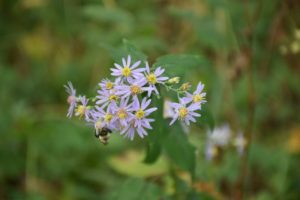
Photo: Honey bees are pollinating wildflowers on the Carlson’s property.
Protect oak trees from oak wilt by waiting until after July to prune
By Don Kissinger, DNR urban forester (Wausau), Don.Kissinger@wisconsin.gov, 715-359-5793 and Paul Cigan, DNR forest health specialist (Hayward), Paul.Cigan@wisconsin.gov, 715-416-4920
To protect oak trees and help prevent oak wilt, the Wisconsin Department of Natural Resources advises people to avoid pruning oaks on their property from April through July.
Spring and early summer pruning makes oak trees vulnerable to oak wilt, a fatal fungal disease that rapidly kills trees in the red oak group and weakens those in the white oak group. Any tree damage during this time creates an opening that exposes live tree tissue and provides an opportunity for the oak wilt fungus to infect the tree.
The red oak group includes northern pin oak, northern red oak, red oak and black oak; the white oak group includes bur oak, swamp white oak, white oak and English oak.
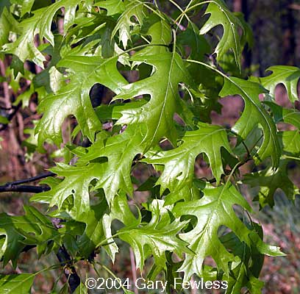
Pin oak (Quercus palustris)
Photo: Gary Fewless, University of Wisconsin, Green Bay
“It takes only a few minutes for beetles that carry oak wilt spores to land on a fresh wound and infect your tree,” said Paul Cigan, DNR forest health specialist in Hayward.
Property owners with oak trees are encouraged to check with their municipality to find out if there are local oak wilt ordinances which may have different pruning restrictions.
The use of tree paint or a wound dressing is not normally recommended on pruning cuts or wounded surfaces on most trees. But for damaged oaks, the use of such products are suggested from April through July. An immediate light painting of wounds or cuts on oak trees during this time helps protect against the spread of oak wilt by beetles.
Don Kissinger, a DNR urban forester in Wausau, said there are also other important reasons to avoid pruning many kinds of deciduous trees in spring beyond concerns about oak wilt.
“Spring is the time when tree buds and leaves are growing, leaving the tree’s food reserves low,” Kissinger said. In general, the best time to prune trees is in winter.
Oak wilt and other diseases move easily on or in firewood logs year-round. To protect trees in general, don’t move firewood long distances, or only use firewood labeled as Wisconsin-certified.
As of January 31, 2018, oak wilt has been found in all Wisconsin counties except Douglas, Bayfield, Ashland, Iron, Forest, Taylor, Door, Kewaunee, Calumet, and Manitowoc counties. Several of these counties contain the highest abundance of healthy and productive oak forests in the state. Taking recommended precautions with living oak trees and keeping firewood local to prevent the spread of oak wilt will help keep them that way for years to come.
More information is available online at the WI DNR website, including a recently released video on oak wilt. Visit the DNR website, https://dnr.wi.gov/, and search for “oak wilt” or “firewood.” Additional information about proper pruning techniques is available from community foresters or by searching for “tree pruning.”
Building a Community Ecology Project
Contents of this article are shared for informational purposes only. The Wisconsin Department of Natural Resources does not endorse and makes no representations, expressed, inferred or implied, concerning these organizations, programs or services.
By Paul Fliss, City Forester, City of New Berlin, WI
The City of New Berlin applied for a National Fish and Wildlife Federation (NFWF) Five Star and Urban Waters Restoration Grant in 2017. The proposed project will cover 9.59 acres and encompass the length of Deer Creek and the wetlands to the south and east of the City Center Business District. Common to this area are several species of resident birds, migratory songbirds, owls and waterfowl. Recent history has revealed an abundance of whitetail deer and smaller animals such as muskrats, raccoon, opossum, skunks, various mice/voles and even evidence of a beaver. The habitat for these species is that of an urban to rural interface and wetland transition ecology. The current state of the defined proposal areas vary between ‘poor’ with construction debris, litter and heavily infested invasive species to ‘fair’ with few invasive species and nearly undisturbed lowland habitat, native trees and wetlands plants. Continue reading “Building a Community Ecology Project”
Update on EAB in West Bend
Written in conjunction with Mike Jentsch, West Bend Parks and Forestry
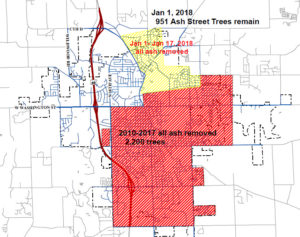 The city of West Bend is in Washington County, about a 30-minute drive north of Milwaukee. More than 32,000 people call West Bend home. Emerald ash borer was first confirmed in West Bend on June 9, 2010. The DNR Urban Forestry team previously showcased West Bend’s efforts to mitigate EAB in the city. We are showcasing West Bend again to show how their EAB efforts have changed as the pest grows and effects more and more trees. Their efforts can help shed light their hard work and guide communities that are just now being affected. Continue reading “Update on EAB in West Bend”
The city of West Bend is in Washington County, about a 30-minute drive north of Milwaukee. More than 32,000 people call West Bend home. Emerald ash borer was first confirmed in West Bend on June 9, 2010. The DNR Urban Forestry team previously showcased West Bend’s efforts to mitigate EAB in the city. We are showcasing West Bend again to show how their EAB efforts have changed as the pest grows and effects more and more trees. Their efforts can help shed light their hard work and guide communities that are just now being affected. Continue reading “Update on EAB in West Bend”
Updated forest health fact sheet – conifer bark beetle

Spruce beetle (Dendroctonus rufipennis). Photo: Edward H. Holsten, USDA FS, Bugwood.org
The Division of Forestry’s forest health team recently updated another forest health fact sheet about conifer bark beetles. Like the oak wilt and hickory dieback and mortality fact sheets revised earlier this year, the conifer bark beetle publication offers information about biology, impact, prevention and management of the insects. The conifer bark beetle fact sheet is available on the DNR’s forest health webpage.
Written by: Mike Hillstrom, forest health specialist, Wisconsin Dells. Michael.Hillstrom@Wisconsin.gov; 608-513-7690
Oak wilt and hickory mortality Forest Health Fact Sheets are available
The forest health program is in the process of updating some of our publications as Forest Health Fact Sheets. These publications offer biology, impact, prevention and management information about specific threats to forest health. Our new oak wilt fact sheet and hickory dieback and mortality fact sheet are currently available on the DNR’s forest health oak wilt and bark beetle webpages and will be available in the DNR’s online publications catalog in the near future. Enjoy!
Written by: Mike Hillstrom, forest health specialist, Wisconsin Dells (Michael.Hillstrom@Wisconsin.gov), 715-459-1371.
